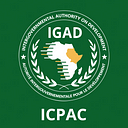Many parts of the tropical Eastern Africa have two distinct rainfall seasons, centred around March-May (MAM) and October-December (OND) months. The March-May and October-December rainfall seasons are normally referred to as the long and short rainfall seasons respectively due to the corresponding number of rainfall days and the general amounts of rainfall received at the individual locations. In 2019 anomalies were observed in several locations with extreme drought being observed in March-May and extreme flooding in October-December rainfall seasons. These floods have resulted in loss of lives, property, livelihoods, displacements and mass migrations of people even in the usually dry Arid and Semi-Arid lands.
The October-December 2019 forecast given by ICPAC during its Fifty Third Greater Horn of Africa Climate Outlook Forum (GHACOF 53) indicated higher likelihoods for normal to above normal rainfall in most parts of the region. The impacts of hazards like the October-December 2019 floods, are often exacerbated by the vulnerability and lack of coping capacity by the society, as well as the exposure of their geographical locations, that puts them within the paths of such extreme hazards.
Some of the key climate phenomena that have been associated with rainfall extremes in the Eastern African region are El Niño/ Southern Oscillation (ENSO), the Indian Ocean Dipole (IOD) and Tropical cyclones. The 2019 IOD index recorded one of it’s strongest positive values since 1961, when records of IOD indices began.
The extreme rainfall being currently experienced in Eastern Africa is closely linked to this positive phase of the Indian Ocean Dipole (IOD). In cases where the Sea Surface Temperature (SST) in the western Indian Ocean is higher than in the eastern side, a positive IOD is recorded — resulting in a massive low-pressure system accompanied by extreme wind and precipitation anomalies across large areas of Eastern Africa.
One of the most extreme climate hazard occurrences during 2019 October-December rainfall season was the simultaneous development of three cyclones over the western Indian Ocean during the first week of December. This was the first time that such an event was observed since the beginning of records on cyclones over the western Indian Ocean sub region in 1961. This comes after cyclone Idai and cyclone Kenneth hit Mozambique and neighbour countries within the space of a few weeks in March and April 2019. Idai and Kenneth were recorded as the worst tropical cyclones on record to affect the southern African region.
The Intergovernmental Panel on Climate Change (IPCC) attributes climate change to changes in either mean or variability of climate that persists for an extended period, typically decades or longer. The World Meteorological Organization (WMO) reported in 2019 that the years 2015-2018 were the top four hottest years on record — 2019 is on track to be within this group of warmest years. According to the WMO, the warming of the planet is driven by increased emissions of heat-trapping carbon dioxide (CO2), which have also reached record levels . The report [1] noted that ocean heat content is at a record high and global mean sea level continues to rise. The report further states that the Earth’s climate has been warmer than the 20th Century average over the last 406 consecutive months. That means no one under the age of 32 has ever experienced a cooler-than-average month.
The big question is, can we attribute the observed 2019 October-December flooding to climate change? The answer can be provided through improved regional research together with enhanced climate observational network, data management, modelling, and strengthened climate risk management strategies to reduce risks associated with climate variability and change.
It is therefore very important that research is undertaken by WMO, Regional institutions like ICPAC, the regional universities and research institutes, and National Meteorological and Hydrological Services (NMHSs) to examine evidences of climate change contributions to regional climate extremes like those observed in the 2019 October-December season over eastern Africa. Such research must be multi/inter disciplinary and address not only the detection, but also attribution of regional weather and climate extremes to associated impacts and potential strategies for coping with climate extremes, whilst adapting to future changes linked to climate. Such research should also address how best to contribute to the UNFCCC mitigation processes including support to the Nationally Determined Contributions (NDCs) which is a cornerstone of the Paris Agreement, aimed at limiting the increase in global average temperature, to below 2°C, and preferably below 1.5°C.
Footnote: [1] WMO Statement on the State of the Global Climate in 2018 WMO-№1233 (2019) Geneva 2, Switzerland, ISBN 978–92–63–11233–0
